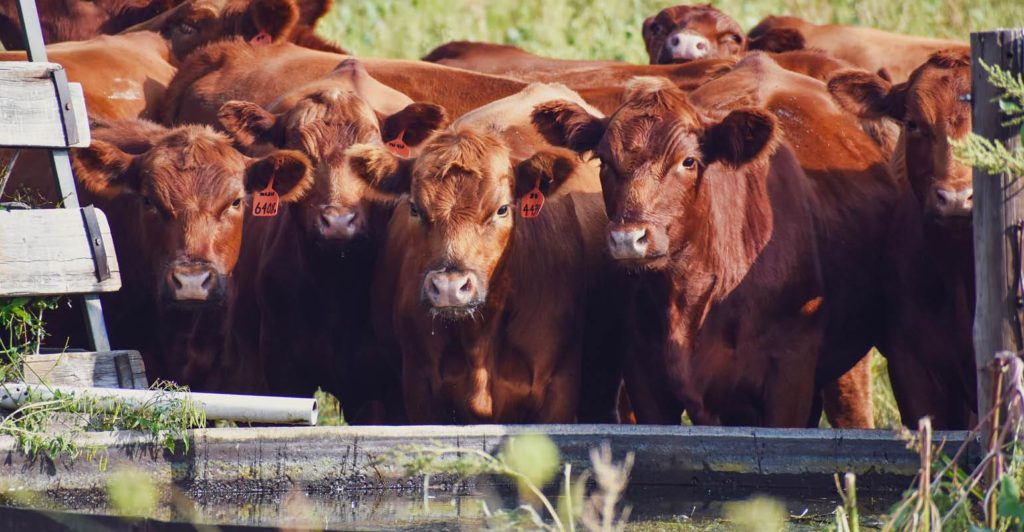Where we have been, and where we are going?
The idea that there are predictable patterns in the inheritance of DNA that help inform what a phenotype will be, go as far back as 1863, with Gregor Mendel and his well-known pea experiments. He learned, through years of experimenting, that there was a predictable relationship between the pea shape of two “parent” plants, and that of their “offspring”. These “Basic Laws of Inheritance” are the same philosophy applied to simply inherited traits such as coat color and polled status in cattle. However, as technology and research progressed, Mendel’s Laws of Inheritance transformed into the study of animal breeding, along with many others.
One of the simplest equations an Animal Breeder learns in is P = G + E. In simpler terms, an animal’s phenotype, or what we visibly see, is a combination of their genotype, or genetic potential, and the environment in which they are raised. That equation is the basis for a majority of the work that geneticists do today. Understanding that the environment and management practices of an animal may vary based on geography, nutrition and many other circumstances, animal breeders focus on using their training to estimate the genetic potential, or breeding value, of an animal to help cattlemen better predict their phenotypic performance. To do that, they calculate EPDs, or estimated progeny differences.
Just like Mendel’s idea of inheritance of simple traits, the same overall concept is applied with more complicated traits such as birth weight and calving ease. For quite some time, genetic evaluations have been used to characterize the genetic potential of registered cattle to ensure the correct animals are being selected and propagated for key economically relevant traits. To do this, seedstock producers invest heavily into reporting the key pieces of information that go into calculating an EPD – including individual animal pedigrees, recording phenotypes for key traits on that animal themselves, and then any phenotypes reported on the progeny of that animal. The overall outcome being, if you know the EPD or genetic potential of a sire and dam, you can then use that as a proxy for how their offspring will perform, on average.
When an EPD is reported back to the seedstock producer, the true estimate of genetic merit in an animal is summarized in three different ways:
- Estimated Progeny Difference (EPD): This is the estimate of genetic merit that an animal will pass on to their offspring and is normally the first number listed following the trait abbreviation. The EPD is also published as a deviation from the breed average for that trait. For example, if the breed average for birth weight is 72 lbs, then a bull with an EPD of 0 for birth weight would be expected to have calves with a birth weight of 72 lbs, on average. Similarly, if another bull has an EPD of -1.0 for birth weight, he would be expected to have calves with an average birth weight of 71 lbs.
- Accuracy: This value ranges from 0 to 1 and is as an estimate of the confidence that the EPD provided is in fact the actual EPD of the animal. After all, an EPD is a geneticist’s best estimate of genetic potential in an animal, given the information provided to them at the time. However, as more progeny records are reported, that estimate is likely to move up and/or down. The higher the accuracy, the less likely an animal’s EPD is to change as more information comes into the genetic evaluation.
- Percentile Rank: Normally the last, or bottom value, a percentile rank reports where the specific EPD for that animal ranks across the entire breed. Ranging from 1 to 100, if an animal is in the top 1%, they are one of the best animals in the database for that trait of interest. While sometimes useful to gain bearings as to what a “good” or “bad” EPD looks like, it is recommended that seedstock producers use the EPD when making selection and bull buying decisions.
So how did we transition from EPDs to GE-EPDs? Due to basic biology, officially termed Mendelian sampling, there are over one quintillion possible combinations of DNA that full sibling calves can inherit, no matter the sire. Traditionally it has taken several years of recording phenotypes of progeny to characterize which calves inherited the “good” genes from their parents. Genomic testing is a tool to characterize what specific genetic merit an animal inherited at a younger age than has been feasible from pedigree information and progeny records alone. The use of genomics, or DNA, in genetic evaluations has been happening for about a decade, providing “Genomic Enhancement” to the EPDs producers were already accustomed to. Experience has shown the addition of genomic information to an existing pedigree based evaluation has several impacts:
- It increases the accuracy of the EPD. This provides more confidence in a bull’s performance, and a decrease in the likelihood that the EPD will drastically shift over time.
- It decreases the generation interval. Genomically testing an animal provides as much information to a genetic evaluation as if they had already sired from 8 to 33 calves, depending on the trait. This provides the ability to make decisions faster, decreasing the generation interval.
- It allows for more accurate evaluation of traits that are hard to measure, or are measured later in life like carcass traits, stayability, and heifer pregnancy.
Selling bulls with genomically enhanced EPDs is a standard practice to ensure that when a young bull is sold to a commercial rancher, he will perform as expected. In other words, purchasing a heifer bull will not lead to a calving season filled with pulling calves. Genomic testing increases the confidence a seedstock producer has in the bulls they are selling, as well as the confidence the commercial customer has in their purchase.
For the future, the path to having dramatically improved offerings of bulls requires the addition of genomic testing, today. The increased accuracy from genomic testing leads to improved selection of animals that meet an operation’s breeding objectives. This ultimately leads to an improved overall quality of your bull offering and alignment with the needs of your customer base.
SOURCE: Jamie T. Courter, Ph.D. – Beef Product Manager, Neogen Genomics








